Knights in color
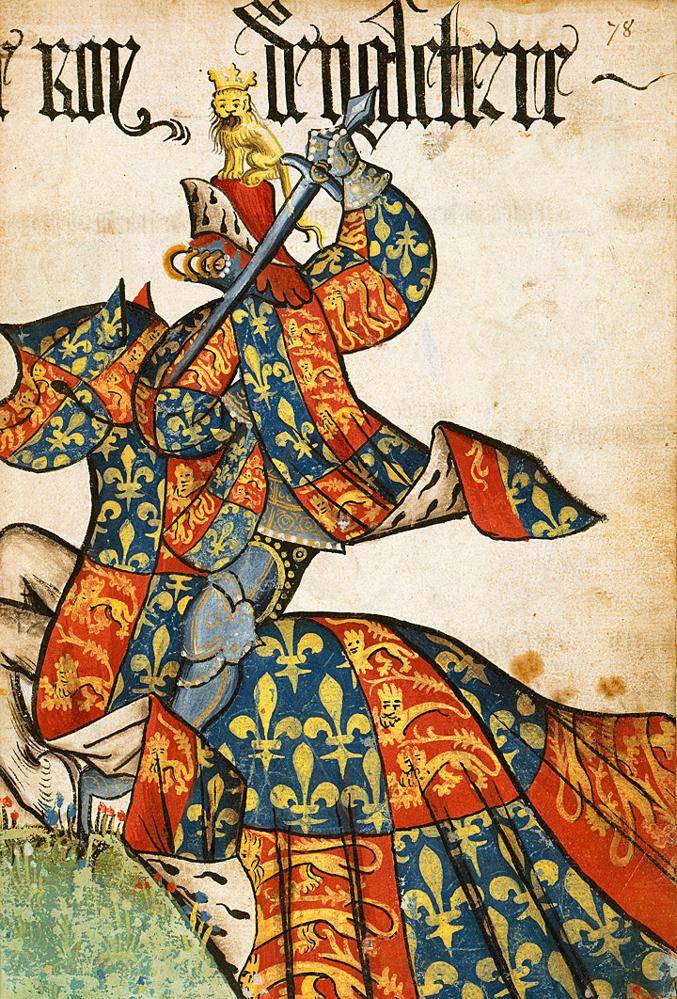
And fresh leaves and flowers
And in the green of thick branches
The sound of clear voices,
A flock of birds huddle there.
Miley - eyes on the meadows
Count the tents here and there
And, waiting for the fight,
Glide through the ranks of knights
And saddled horses.
Bertrand de Born. Translation by V. Dynnik
History Middle Ages. The textbook of the history of the Middle Ages for the 6th grade says that at first the main armor of the knight was chain mail, which was then replaced by metal armor. But it doesn't say when or how it happened. And then there are legends that the knights recovered right in armor and all sorts of other absurdities.
But the most interesting thing is that with this approach, a whole period disappears from the military history of the Middle Ages, when chain mail, and later armor, was hidden by bright and elegant clothes. Actually, there is nothing at all about this in the textbook, and after reading it, one gets the impression that the Middle Ages were a dark and completely wild time, and people were absolutely rude and ignorant. And although this was indeed the case, not everyone was like that at that time. Well, as for the brightness and colorfulness of clothes, this may well argue with the so-called New Time.
However, it is precisely in this matter - when the knights had chain mail “under the bottom”, and colorful robes covered it from above, there is no exact clarity. So let's consider this issue today using the examples of all the same medieval book miniatures that are already quite familiar to us. So…
The first example of patchwork clothing that we know was a caftan on Bishop Odo from Bayesian Embroidery. All the other warriors, including Guillaume Bastard himself, are shown in naked chain mail, but here he is in something that is embroidered with triangles, like a peasant blanket. It is unlikely that it was a fabric with such a pattern, although who knows.
Then came a whole century of naked chain mail. There is more and more mail armor on the warriors, it already covers the arms, legs, and head, but no one even thought of putting something on top of the chain mail attire. Naturally, the "color of the knight" was not too bright at that time, the dark color of the metal, and maybe with a brown tint due to rust. After all, he didn’t always have a barrel for cleaning chain mail at hand, and no one canceled the rain and fog during the then wars!
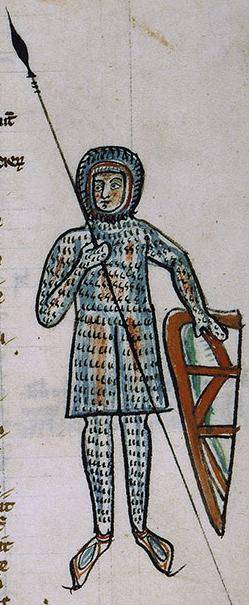
But here is an image of a warrior, dating back to the first half of the 1226th century. "Bible" 1250-XNUMX England. Municipal Library of Angers
He wears only chain mail armor, although, as we know, at that time the crusaders already went on crusades, visited the hot sun of Palestine and began to wear robes over chain mail like a long caftan - a surcoat. When with sleeves, and when without sleeves. So - someone at that time did without this important detail of the costume.
And if there were no clothes on the rider, then no one put anything on the horse. And at the same time, it was during this period that horse blankets appeared on horseback. The only question is what appeared first - a surcoat on a rider or a blanket on a horse?
And here miniatures from the Pomplon Illustrated Bible come to our aid. It dates back to 1200, and in its miniatures we see many horsemen. And they are all in chain mail from head to toe, including chain mail stockings, and long sleeves of haubergs with gloves woven into them, but none of them is wearing a surcoat. But their horses are almost all in blankets! True, on one warrior on the right in the miniature below, something like a caftan is visible, but basically all the horsemen, unlike the foot soldiers, are in chain mail.
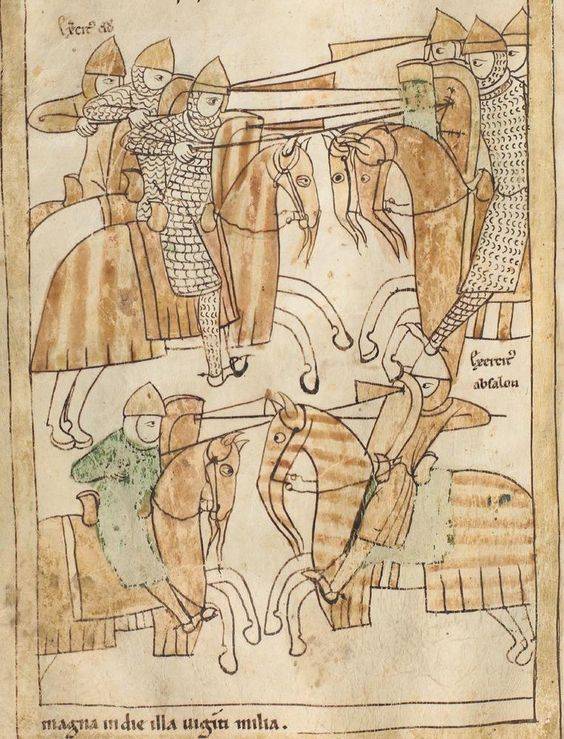
Pomplonskaya "Illustrated Bible and Lives of the Saints", 1200 Pamplona, Spain. University Library in Augsburg
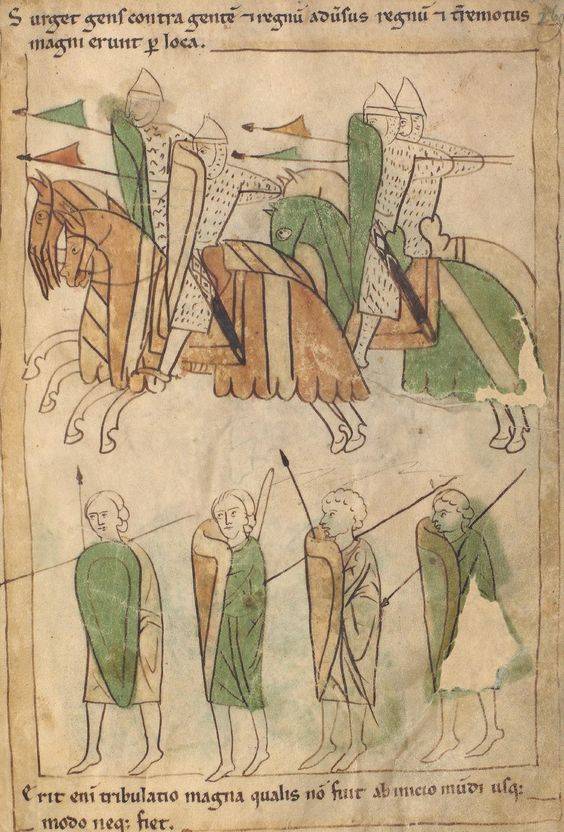
Another illustration from Pomplon's Illustrated Bible and Lives of the Saints. Riders and foot soldiers
That is, in Spain, at least, blankets on horses appeared earlier than surcoats on riders. Very interesting, isn't it?
But, perhaps, this was typical only for Spain, while in other countries it was the surcoat invented before horse blankets?
Let's take a look at another miniature from the "Big Chronicle" by Matthew Paris.
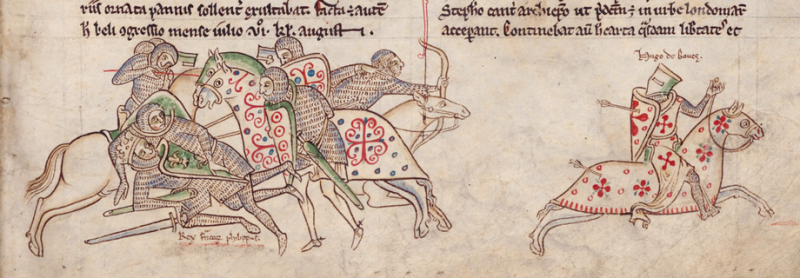
It depicts the cowardly Hugues de Beauve running from the battlefield of Bouvines (1214) and being shot in the back by an arrow. True, he manages to substitute his shield. "Big Chronicle" by Matthew of Paris, c. 1250 Parker Library, Corpus Christi College, Cambridge
In this miniature, all the warriors, except for the Hyuuga himself, are dressed in chain mail. One of them has an embroidered blanket and patterned shields on his horse, but no one has a surcoat. Only one Hyug is dressed from head to toe, including his horse, in a coat of arms. That is, there were already coats of arms at that time. The drawing of the coat of arms was placed not only on the shield, but also on the surcoat, and on the horse blanket. But far from everyone. Even the horseman with the crown does not have a surcoat on his helmet, although he is clearly a knight, and not from the poor.
We look at the German sources.
Before us is the "Romance of Aeneas", and we see knights in closed helmets (an early form of the tophelm helmet) with helmet decorations and in a surcoat. But the blankets on their horses are clearly not heraldic, but ... armored, from plates in the form of squares sewn on some kind of base. By the way, in other miniatures the image of such blankets is not found, only in this one.
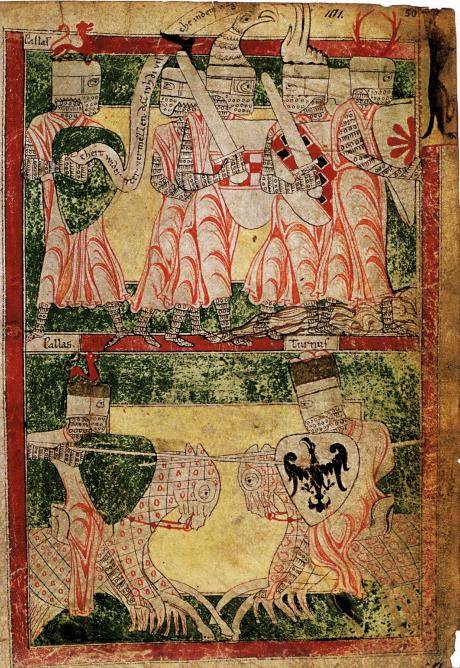
"The Romance of Aeneas", 1210-1220 Thuringia. Berlin State Library
That is, both horse blankets and surcoats appeared somewhere at the turn of the XNUMXth-XNUMXth centuries, but they made their way rather slowly.
We turn to another miniature, this time from the British manuscript of 1250 "Romance of Alexander", and in it we see that two noble knights cut off the heads of their horses, both of them dressed in a surcoat, but here the horse of one of them is naked - without a blanket, but the horse of the second is dressed not just in a blanket. On it is a blanket of chain mail!
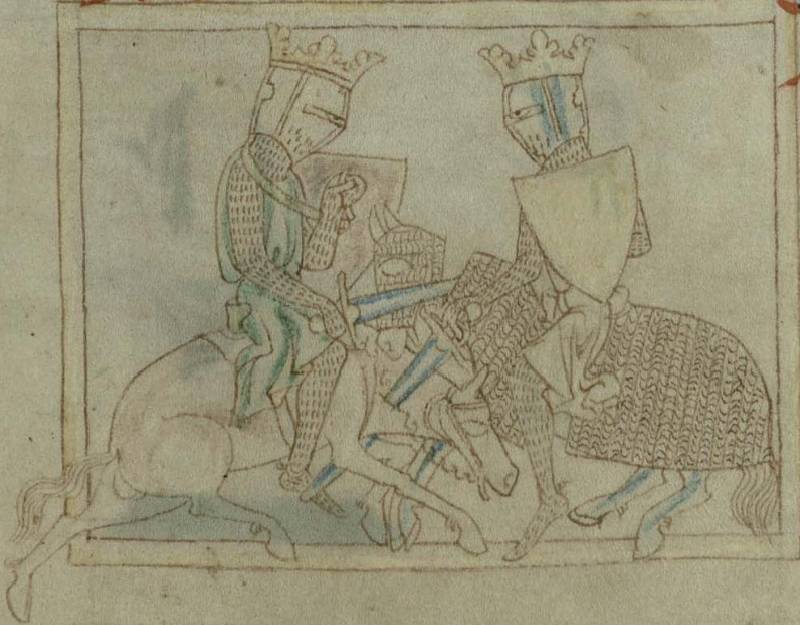
Romance of Alexander, 1250 St. Albans, England, Cambridge University Library
Approximately the same years and another manuscript "The Life of King Edward the Confessor". In the illustration taken from it, we see a very interesting picture - a duel of two knights, two kings, and the one on the left is in heraldic attire, fully corresponding to this time, while on the horse of the second we again see a blanket of chain mail. That is, by 1250 such blankets had already come into use and were quite common.
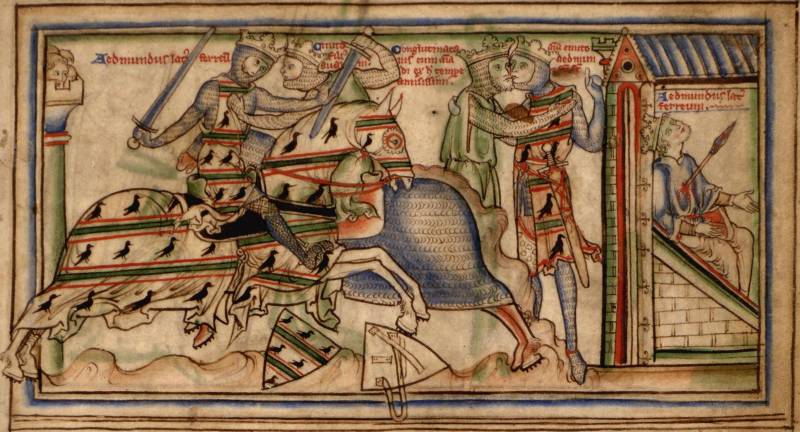
"The Life of King Edward the Confessor", 1250-1260. Cambridge University Library
However, we also have another truly excellent source with exceptionally accurate images of medieval battles - the Maciejowski Bible, written around 1240-1250. There are a lot of battle scenes, so we will limit ourselves to one. On it we see riders in a surcoat, but only one has a blanket on a horse. In addition, the color of the blanket and surcoat fabric is different for everyone. That is, again, the passport of a knight of a surcoat and blanket, it turns out, was far from always at that time! By the way, not all characters are dressed in surcoats in the miniatures from the Maciejowski Bible. That is, someone already wore it, and someone else did not!
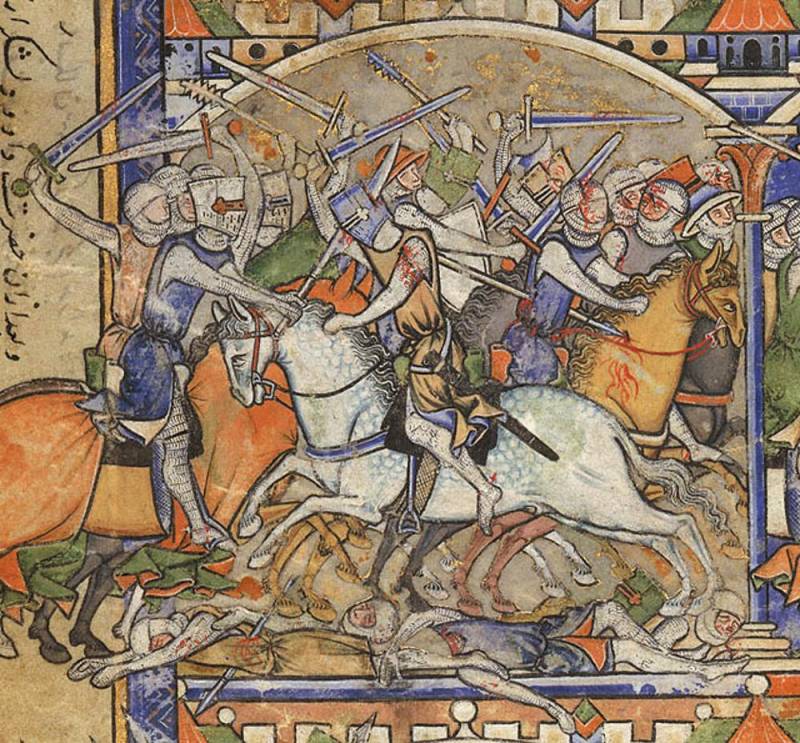
"Bible of Maciejowski, 1240-1250. New York Pierpont Morgan Library
As the days passed, the wearing of heraldic robes became a kind of sign of the times. But when exactly? Most likely, somewhere, again, at the turn of the centuries - XIII and XIV. This is proved by the fact that on the miniatures of the end of the XNUMXth century, almost all the knights are already dressed in surcoats, and their horses are in blankets.

But here we have an interesting miniature from a manuscript from the north of France. On it, someone clearly violated the rule of the left hand, that is, he depicted lions on a horse blanket in a “cowardly position”, that is, back to the enemy, while in this case it was customary to unfold the coat of arms on the right side of the blanket!
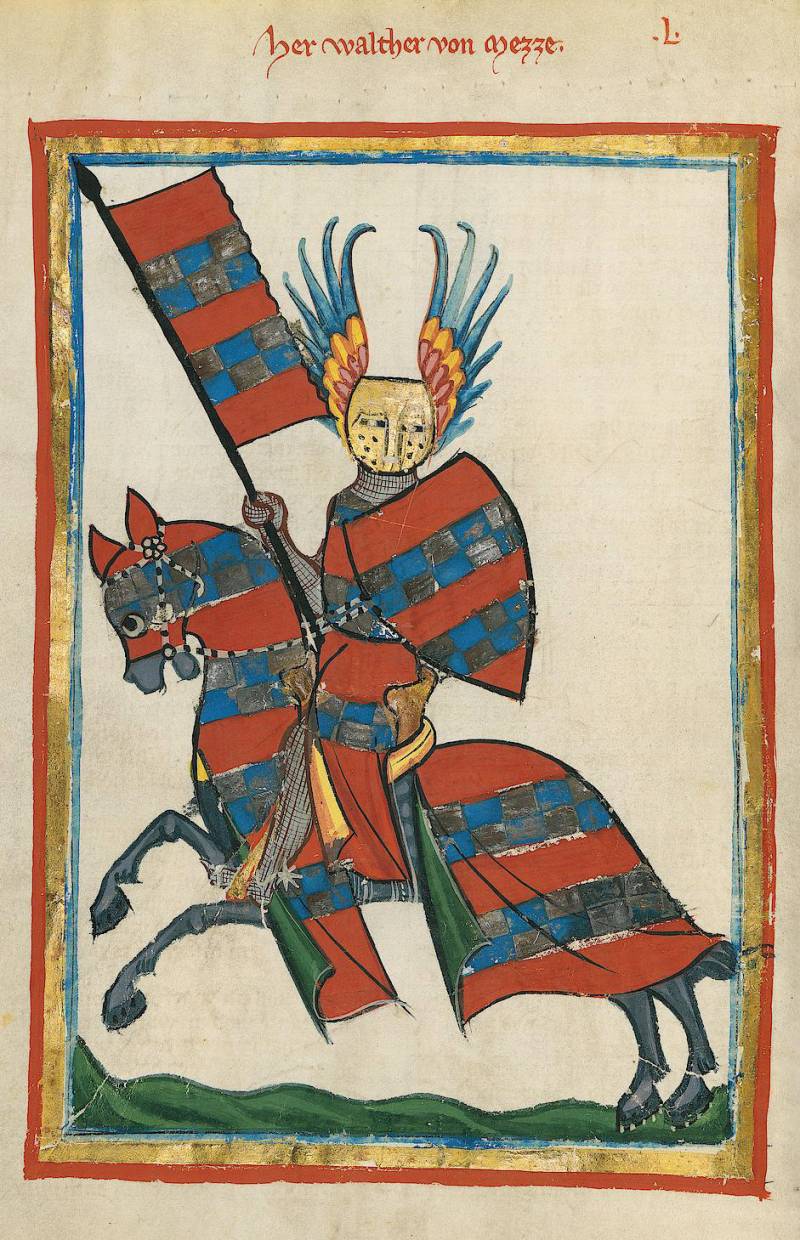
Well, by 1300, probably, most of the knights already looked like, for example, Falter von Metz from the miniature from the Manes Code ... "Manes Code", ca. 1300 Heidelberg University Library
Well, how long were chain horse blankets in use?
After all, we know that later, namely in the XNUMXth century, they were replaced by metal armor. Perhaps, in this case, we have a source of information. This is the famous "Book of the Queen" by Christina of Pisa, a French medieval writer of Italian origin. What this book of hers is about is not important for us now. We are curious about her illustrations, in particular, the one on which we see a horse in a saffron horse mask and a chain mail blanket, and beautifully carved. And here we see a horse in a cloth blanket and another knight, whose horse has a chain mail blanket, but for some reason only on the croup. Probably, he simply did not have enough money for a larger amount of chain mail weaving!
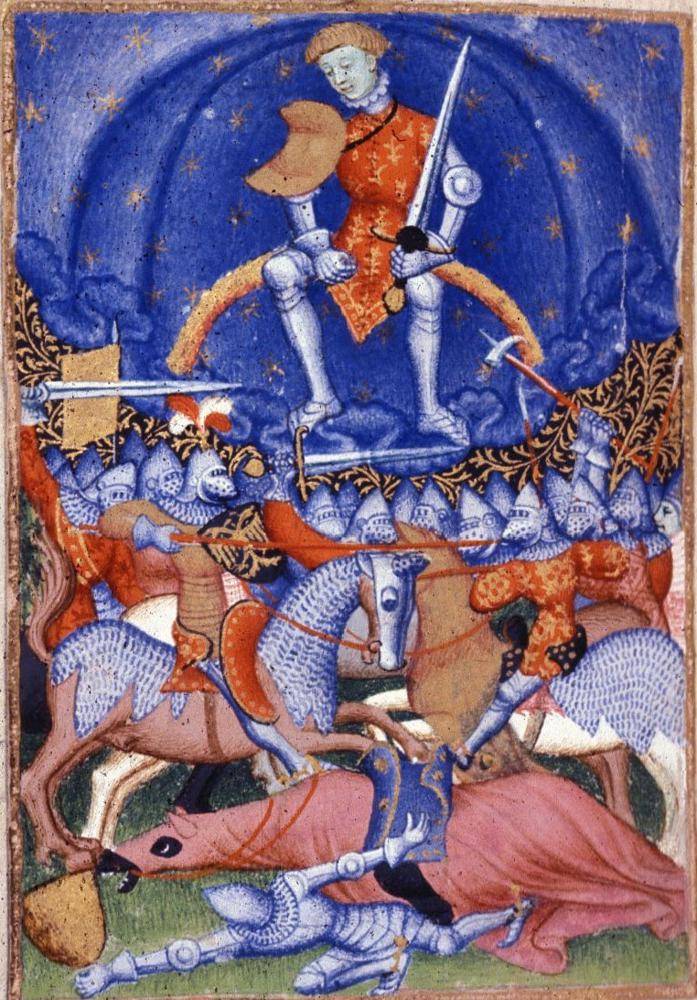
"Book of the Queen" by Christina of Pisa, 1410-1414 Paris. British Library, London
It is interesting that the year 1410 just serves as a kind of watershed between the “epoch of chain mail” and the beginning of the “epoch of white armor”, since just in that year armor began to appear in which the chain mail aventail was already absent on the helmet, and instead a plate collar appeared from a few details.
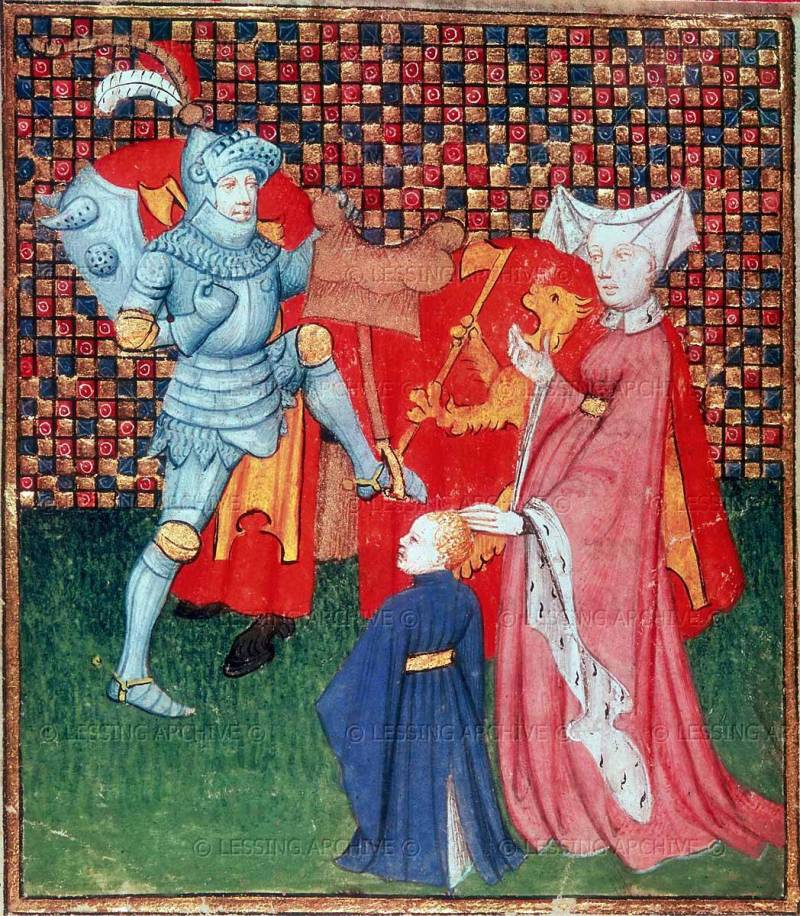
And here is another miniature from the same book, where the knight of this transitional time is depicted. Very accurately the artist conveyed his appearance. He is wearing completely “white armor”, but from under the bevor - a plate collar, still, by tradition (or out of habit), a chain mail aventail peeps out. Well, the horse has a metal saffron, but still a woven blanket
So there is only one conclusion from here - surcoats and horse blankets appeared somewhat at different times, but they began to dominate in the clothes of knights only by 1300, and it took more than 100 years for this!
And, of course, tournament attire - this colorfulness and brightness acquired quite early and for a very long time!
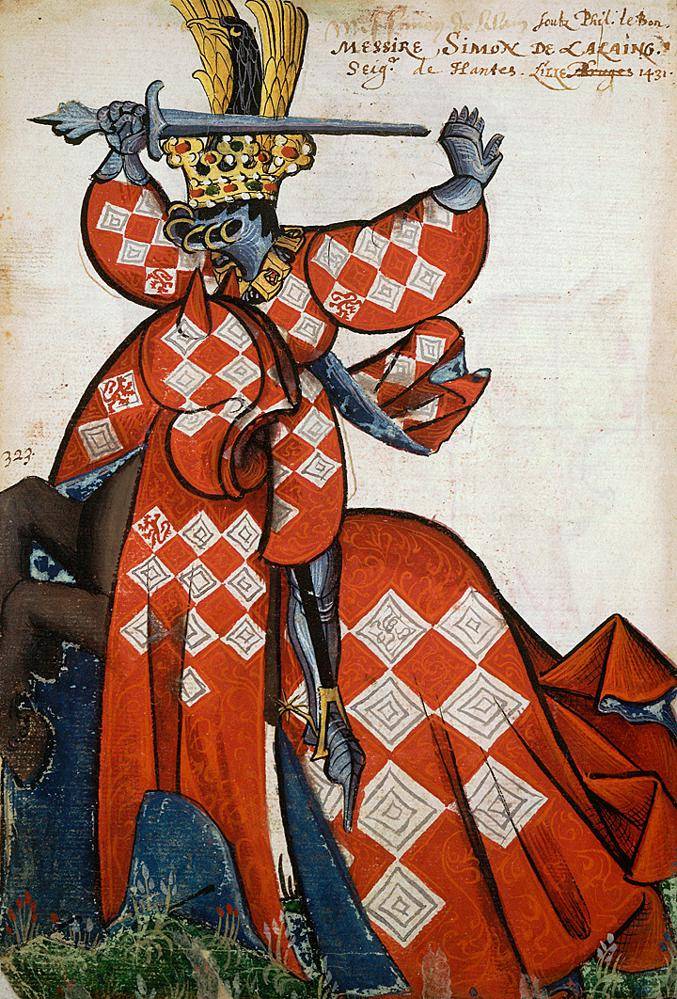
Here, by the way, is one of the examples of such tournament vestments from the manuscript “The Great Armorial of the Knights de la Toison”, 1429–1461. The miniature depicts sir Simon de Lalaing. National Library of France, Paris

And this is none other than the King of England. He has a beautiful outfit, doesn't he? Same source
Information